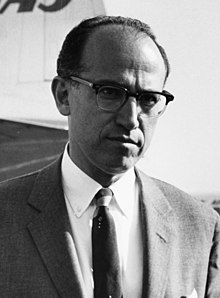Jonas Salk
| Jonas Salk | |
|---|---|

Jonas Salk at Copenhagen Airport (May 1959)
|
|
| Born | Jonas Edward Salk October 28, 1914 New York, New York, U.S. |
| Died | June 23, 1995 (aged 80) La Jolla, California, U.S. |
| Resting place |
El Camino Memorial Park San Diego, California |
| Residence | New York, New York Pittsburgh, Pennsylvania La Jolla, California |
| Fields |
Medical research, virology, and epidemiology |
| Institutions |
University of Pittsburgh Salk Institute University of Michigan |
| Alma mater |
City College of New York New York University University of Michigan |
| Doctoral advisor | Thomas Francis, Jr. |
| Known for | First polio vaccine |
| Notable awards | Lasker Award (1956) |
| Spouse |
Donna Lindsay (m. 1939; div. 1968) Françoise Gilot (m. 1970) |
| Signature | |
|
|
Jonas Edward Salk (/sɔːlk/; October 28, 1914 – June 23, 1995) was an American medical researcher and virologist. He discovered and developed one of the first successful polio vaccines. Born in New York City, he attended New York University School of Medicine, later choosing to do medical research instead of becoming a practicing physician. In 1939, after earning his medical degree, Salk began an internship as a scientist physician at Mount Sinai Hospital. Two years later he was granted a fellowship at the University of Michigan, where he would study flu viruses with his mentor Thomas Francis, Jr..
Until 1955, when the Salk vaccine was introduced, polio was considered one of the most frightening public health problems in the world. In the postwar United States, annual epidemics were increasingly devastating. The 1952 U.S. epidemic was the worst outbreak in the nation's history. Of nearly 58,000 cases reported that year, 3,145 people died and 21,269 were left with mild to disabling paralysis, with most of its victims being children. The "public reaction was to a plague", said historian William L. O'Neill. "Citizens of urban areas were to be terrified every summer when this frightful visitor returned." According to a 2009 PBS documentary, "Apart from the atomic bomb, America's greatest fear was polio." As a result, scientists were in a frantic race to find a way to prevent or cure the disease. In 1938, U.S. President Franklin D. Roosevelt, the world's most recognized victim of the disease, had founded the National Foundation for Infantile Paralysis (known as March of Dimes Foundation since 2007), an organization that would fund the development of a vaccine.
...
Wikipedia

